12 Bibimbap Recipe Guide for Food Enthusiasts around the World
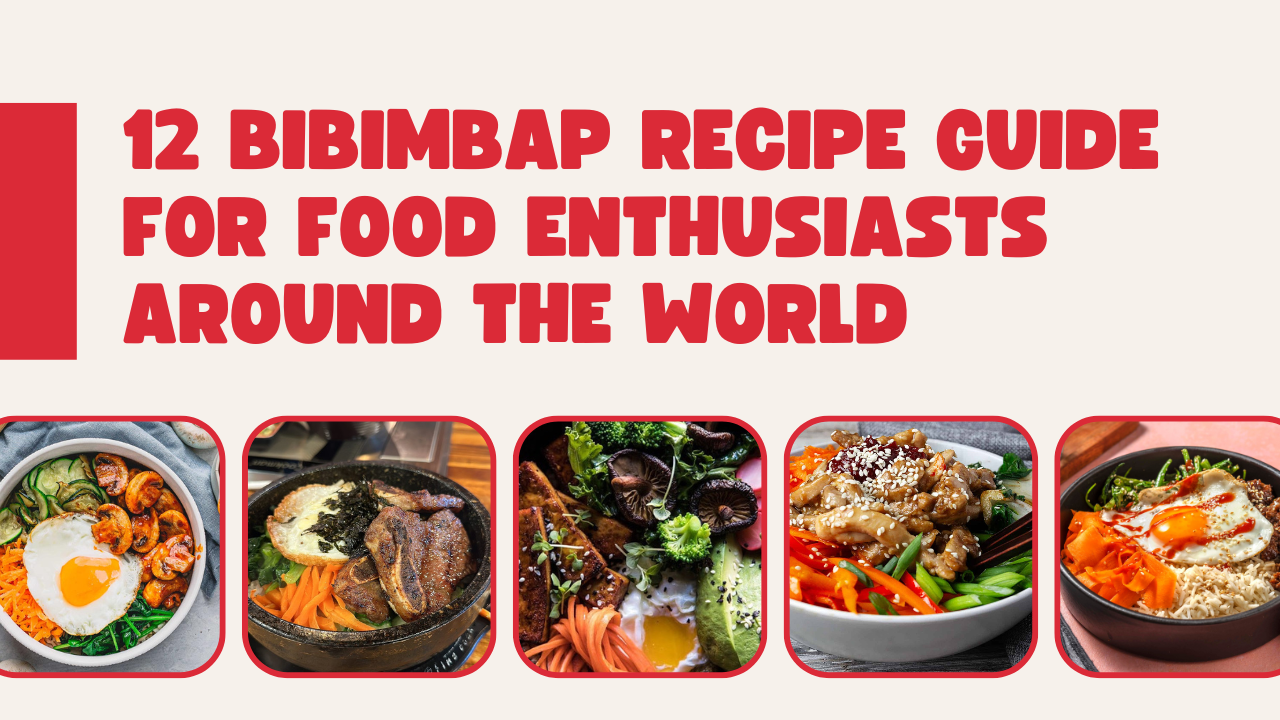
Welcome to our culinary journey through the art of bibimbap. This traditional Korean dish has received international recognition for its vibrant flavors, nutritious ingredients, and adaptability to takeout services. In this guide, we’ll go over the origins, variations, and health benefits of bibimbap, encouraging you to savor every bite of this iconic rice bowl. So lets dive in 12 Bibimbap Recipe Guide for Food Enthusiasts around the World
Table of Contents
Toggle12 Bibimbap Recipe Guide for Food Enthusiasts around the World
Here are some important takeaways:
1. Cultural Significance: Bibimbap represents Korea’s culinary heritage and evolution over time. It is more than just the ingredients; it is also about the dish’s cultural significance and traditions.
2. Versatility: With its numerous variations and adaptations, bibimbap appeals to a wide range of tastes and dietary preferences. Whether you’re a vegan, vegetarian, or meat eater, there’s a bibimbap recipe for you.
3. Health Benefits: In addition to its delicious taste, bibimbap contains essential nutrients, making it a nutritious and satisfying meal option. Its combination of vegetables, proteins, and rice provides a well-balanced and flavorful meal.
4. Global Appeal: People all over the world have fallen in love with bibimbap. From trendy restaurants in New York City to traditional eateries in Seoul, bibimbap has become a popular dish that crosses cultural boundaries.
5. Experimentation: The beauty of bibimbap is in its limitless possibilities. Whether you’re an experienced chef or a home cook, experimenting with different ingredients and flavors allows you to put your own spin on this classic dish. Read more such articles on Vantage Vista Blog.
Understanding Bibimbap
Bibimbap is more than a dish; it is a cultural phenomenon that reflects Korean food’s commercialization and global reach. This savory delight is made up of a medley of ingredients that are beautifully arranged on a plate and are frequently served with banchan, enhancing the dining experience through the commercialization of traditional food service.
Each serving of bibimbap is a harmonious blend of flavors and textures that demonstrates the expertise of Korean culinary traditions as well as the dishes’ adaptability to commercial food service demands.
Origins and History of Bibimbap
Legend has it that bibimbap was a vital part of ancestral rites in Korea, often featured in cookbooks as a traditional dish with deep cultural significance, before its commercialization.
It was originally prepared with leftover rice, vegetables, and meat or fish, making it a convenient meal for busy farmers. The dish evolved over time to include a variety of ingredients, such as banchan and chicken breast, reflecting Korea’s changing culinary landscape and food commercialization.
Bibimbap Ingredients and Variations
Bibimbap is a dish with limitless possibilities for customization. From traditional Jeonju bibimbap to modern interpretations, there are numerous options to suit every taste.
Bibimbap is commonly made with bean sprouts, cucumbers, chicken breast, and a delectable blend of seasonings, demonstrating the versatility of vegetable oil in Korean cuisine.
Preparing the Perfect Bibimbap
Begin a flavorful journey with bibimbap, a popular Korean dish known for its vibrant flavors, nutritional profile, and adaptability to food service and takeout options.
To master the art of making the perfect bibimbap, you must pay close attention to detail and have a strong desire for culinary excellence. Follow this step-by-step instructions to improve your bibimbap-making abilities and impress your taste buds.
Step-by-Step Guide to Making Bibimbap
To make a delicious bibimbap, first prepare the rice as the base. Next, sauté a variety of colorful vegetables, including bean sprouts and cucumbers, in sesame oil for extra flavor.
For an authentic touch, layer these vegetables artfully on a plate and top with a dollop of spicy gochujang. A sprinkling of sesame seeds adds a delicious crunch to any bibimbap recipe and food presentation.
12 Bibimbap Recipe Guide for Food Enthusiasts around the World
The popularity of bibimbap has inspired chefs all over the world to create unique dishes in tribute to the iconic rice bowl. Global fusion cuisines frequently incorporate bibimbap elements, such as colorful vegetables, seasoned meat, and fragrant gochujang, into their recipes.
These bibimbap-inspired dishes provide a delightful fusion of flavors and textures, demonstrating the universal appeal of this beloved Korean dish found in bibimbap restaurants around the world.
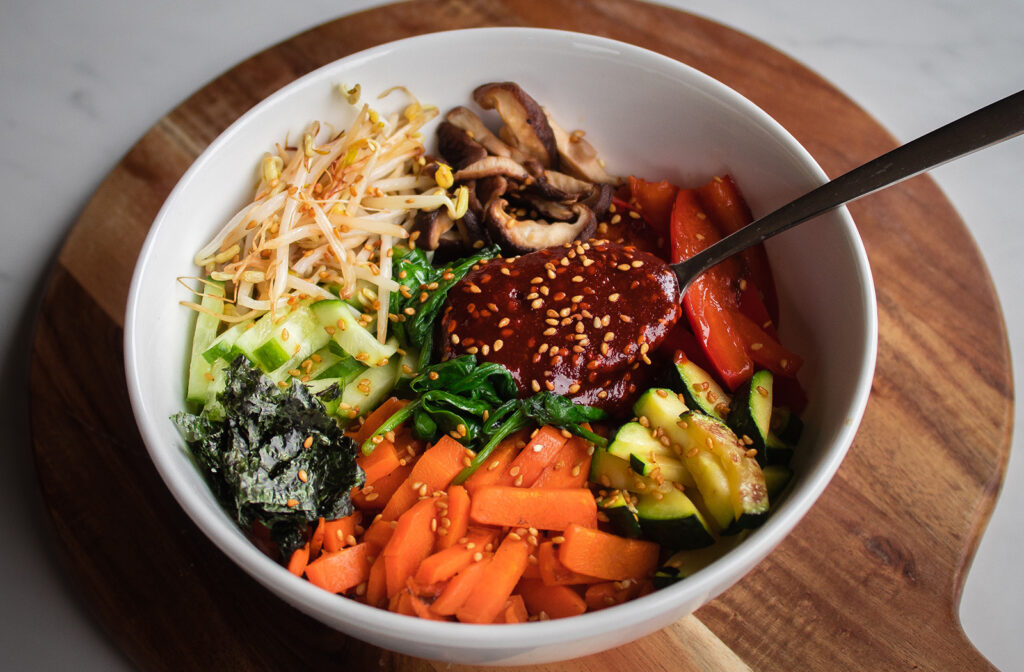
Vegan Bibimbap: A delicious plant-based option with sautéed mushrooms, zucchini, carrots, spinach, and sesame seeds served over steamed white rice. Pair with a refreshing glass of makgeolli, a traditional fermented rice wine.
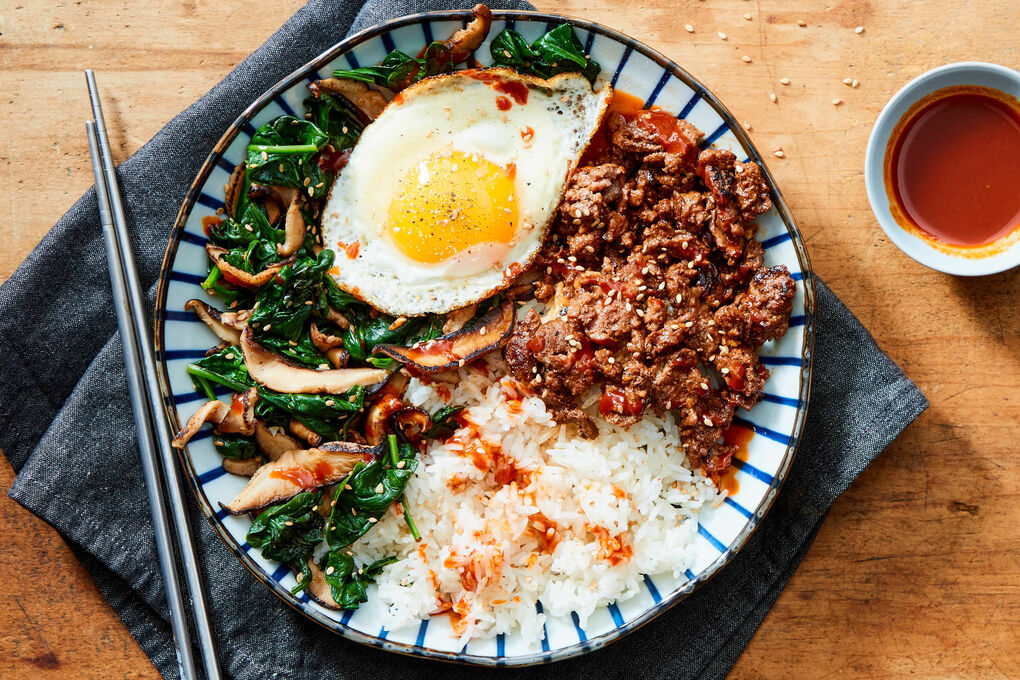
2. Egg Bibimbap: The classic version, with sunny-side up eggs, stir-fried vegetables, and gochujang sauce over rice. Soju, a popular Korean distilled spirit, can be enjoyed alongside your meal.
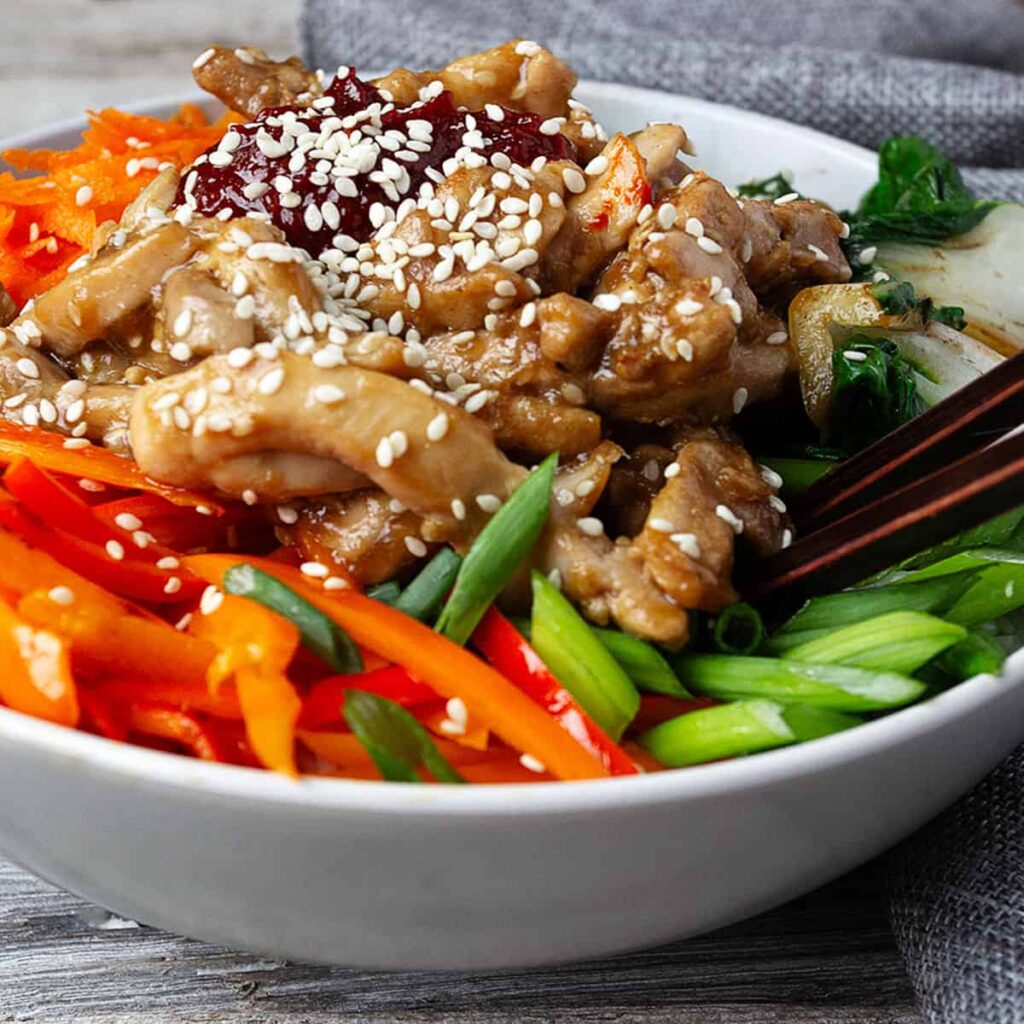
3. Chicken Bulgogi Bibimbap: Marinated chicken bulgogi with mixed vegetables and gochujang sauce. Enjoy this savory dish with a cold bottle of Hite beer.
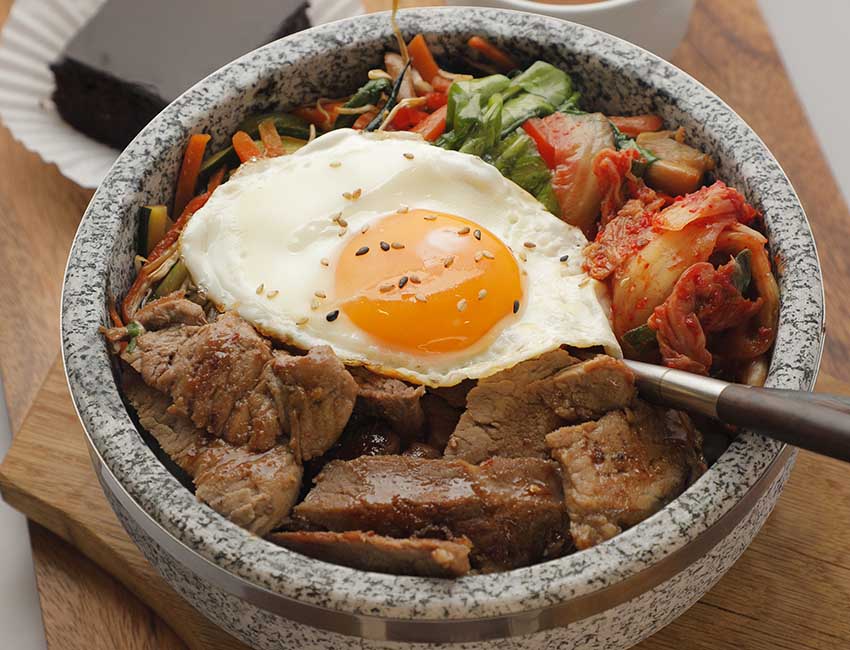
4. Spicy Beef Bibimbap: Thinly sliced beef cooked in spicy gochujang sauce, served with julienned vegetables and rice. Wash down the heat with a glass of maesilcha, a sweet plum liquor.
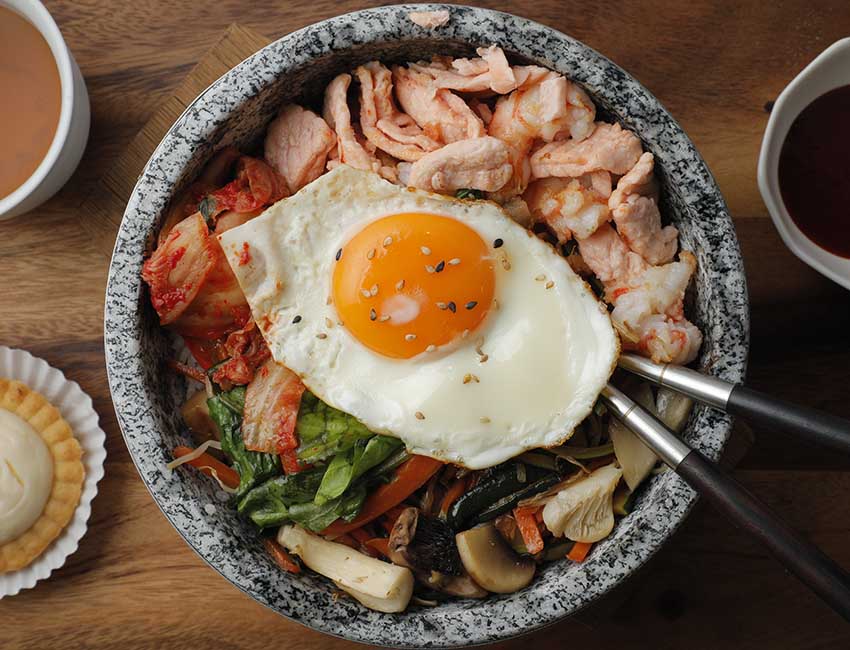
5. Seafood Bibimbap: Fresh seafood like shrimp, squid, and clams are tossed with vegetables and served with rice. Pair this dish with a glass of Soju Mango, a fruity take on the classic soju cocktail.
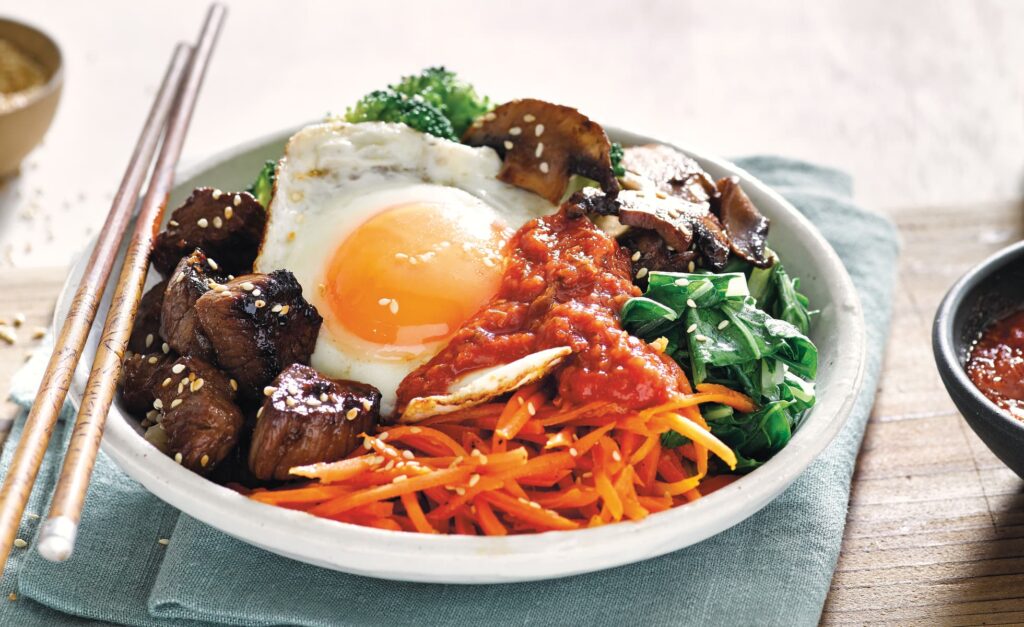
6. Kimchi Bibimbap: This recipe, which includes pork belly, mushrooms, and vegetables, has a tangy kick from the kimchi. A glass of hibiscus tea helps to balance out the flavors.
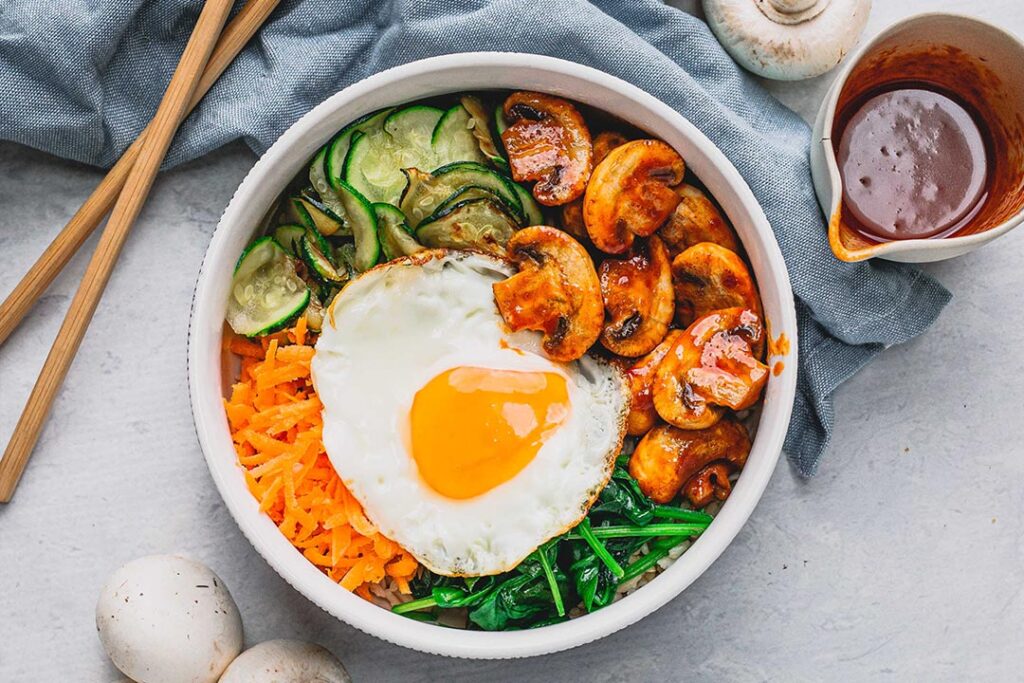
7. Mushroom Bibimbap: is an earthy vegetarian dish made with oyster, enoki, and shiitake mushrooms, as well as vegetables and rice. Try it with a cup of ginseng tea, which has been linked to various health benefits.
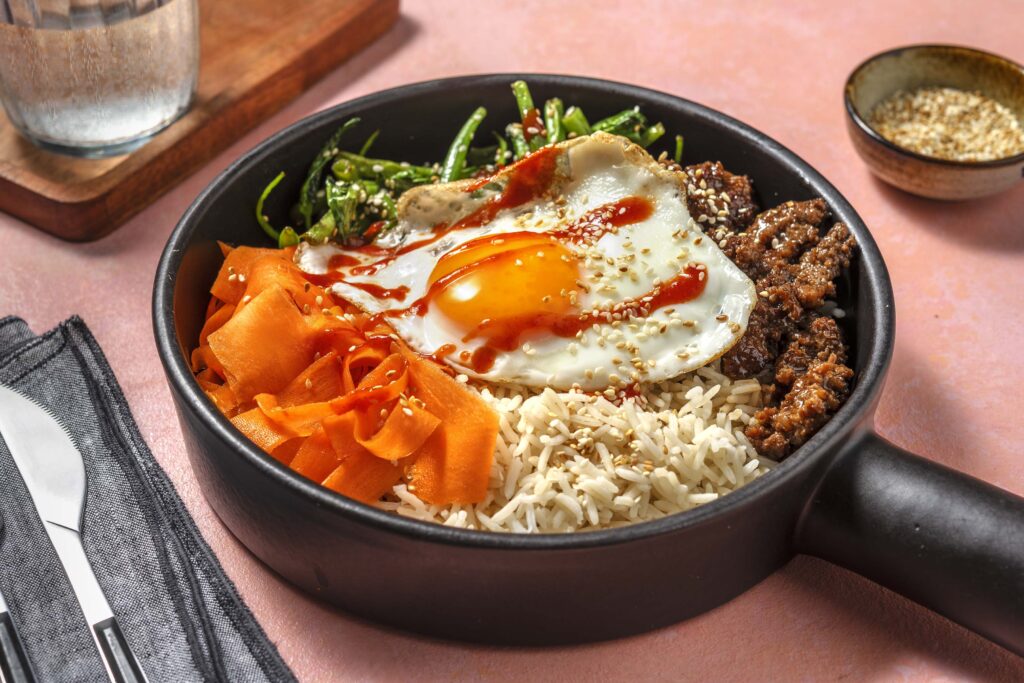
8. Bulgogi Steak Bibimbap: Premium cuts of marbled beef cooked in bulgogi sauce, served with vegetables and rice. Drink a glass of red wine to celebrate this luxurious meal.
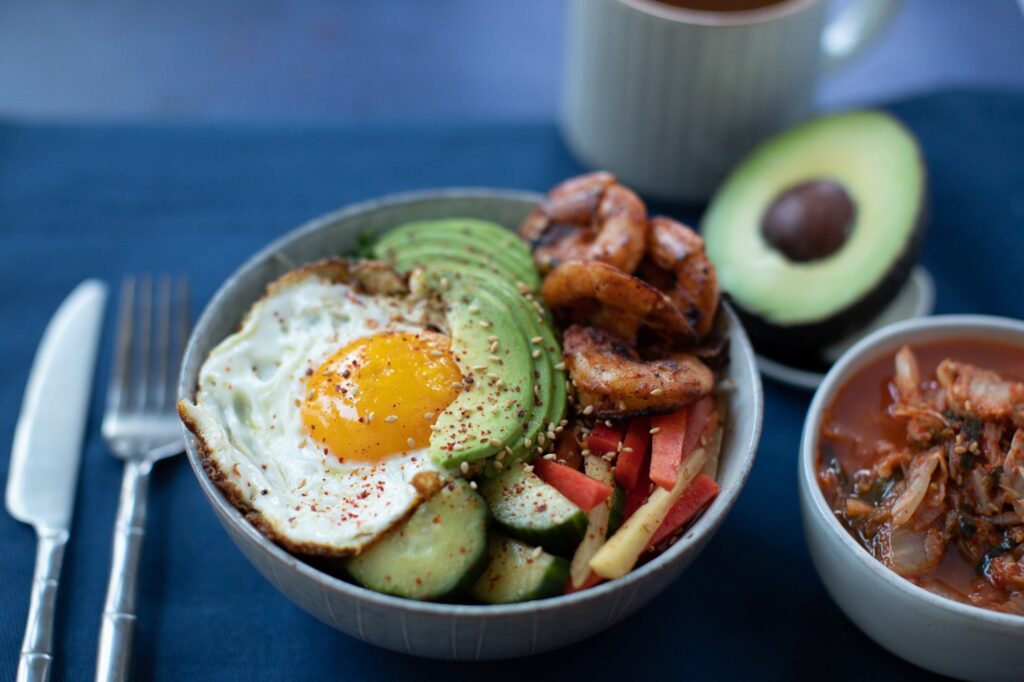
9. Fusion bibimbap: For a Latin American twist, combine salsa, avocado, and black beans, or for a fusion experience, add Indian curries and naan bread.
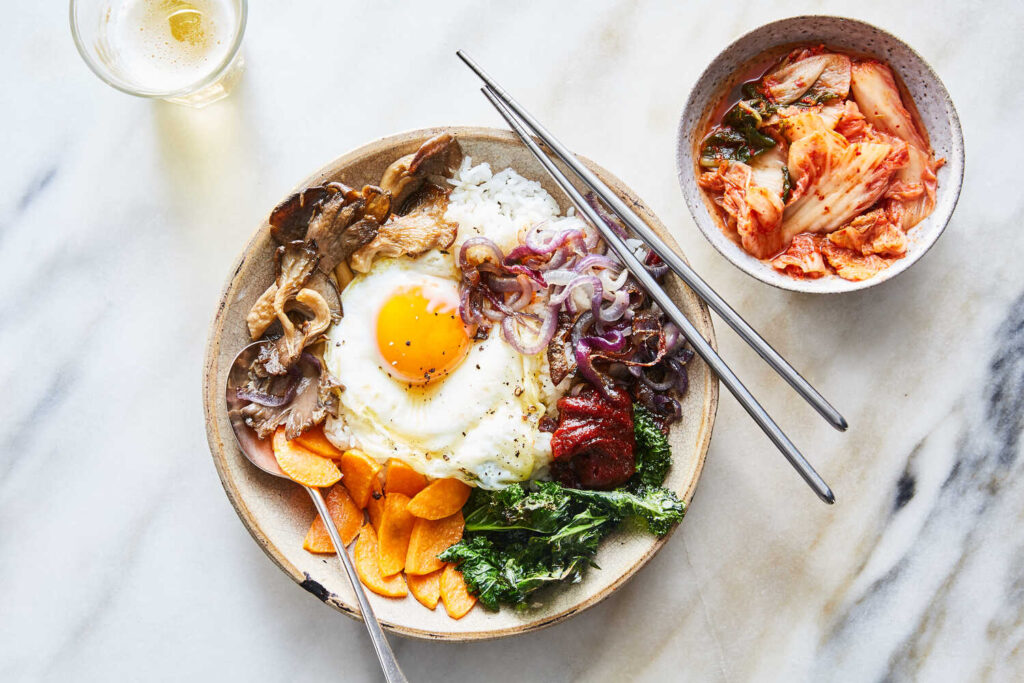
10. Breakfast Bibimbap: Start your day right with a bowl of scrambled eggs, kimchi fried rice, and veggies. Wash it all down with a glass of freshly squeezed orange juice.
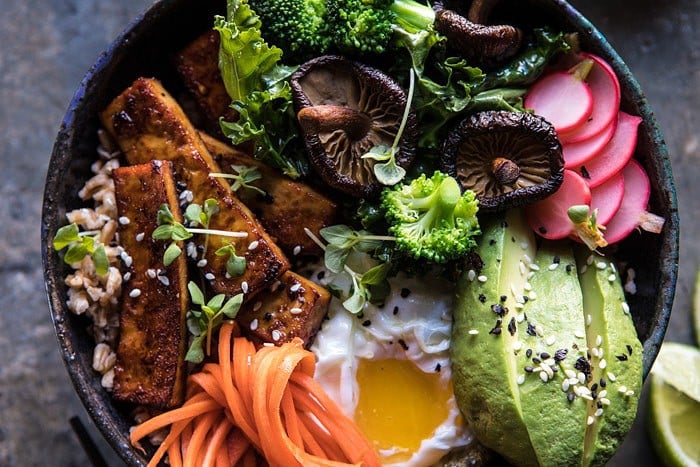
11. Lunchtime Bibimbap: Combine seasonal vegetables, tofu, and brown rice for a light yet satisfying meal. Drink a glass of cucumber water in between bites to refresh yourself.
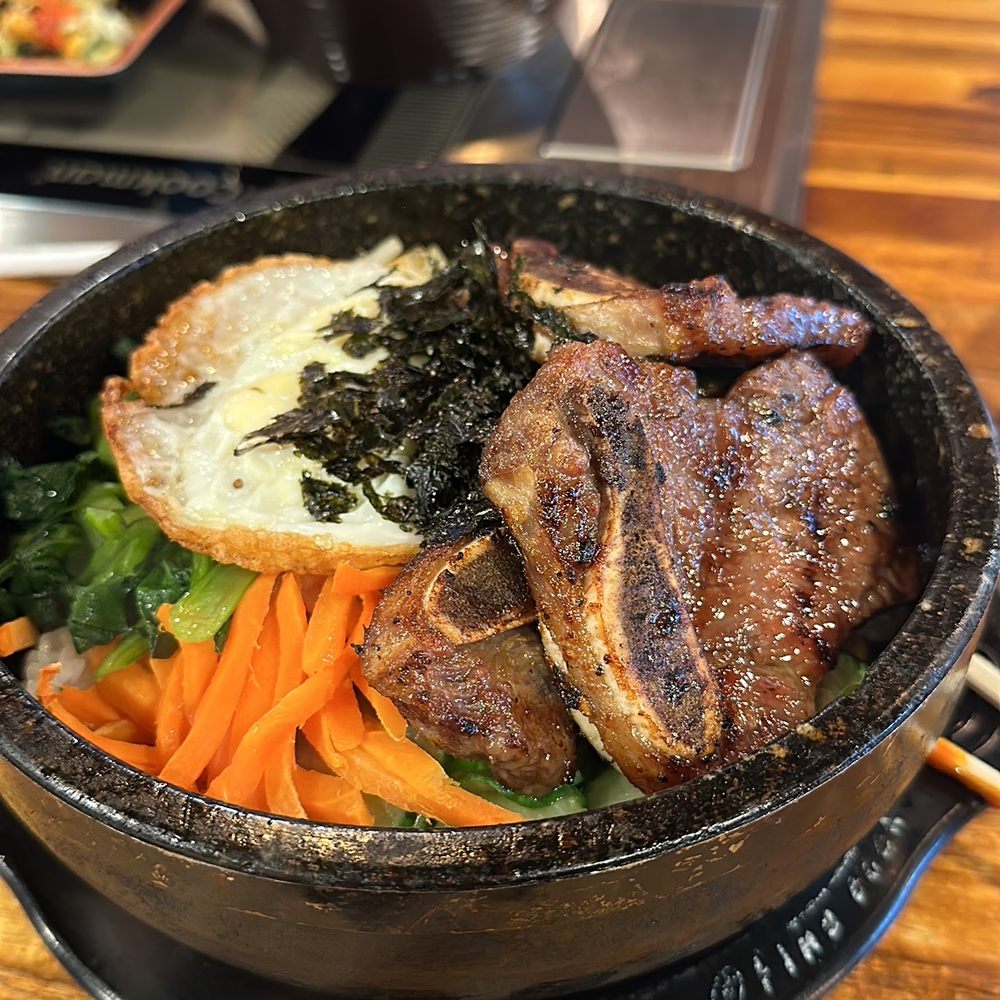
12. Dinner Party Bibimbap: Impress your guests with a lavish spread of tender short ribs, crispy lotus root chips, and a variety of vegetables. Serve with a variety of fine wines to enhance the dining experience.
Tips for Achieving Authentic Flavors
To improve the authenticity of your bibimbap, use traditional Korean seasonings such as red pepper paste and soybean paste, as recommended in many Korean cookbooks, as well as a touch of vegetable oil when frying chicken breast.
Experiment with different vegetable combinations to produce a visually appealing and flavorful dish. Pair your bibimbap with a glass of merlot or chardonnay, or perhaps a red wine, to enhance the dining experience and complement the meal’s robust flavors.
Vegetarian and Vegan Options
Bibimbap lends itself well to vegetarian and vegan adaptations, making it accessible to people with a variety of dietary preferences; truly, bibimbap is a dish that exemplifies recipe and food culture versatility.
Substitute meat with tofu or tempeh for a plant-based protein alternative, and use vegetable oil to achieve the perfect sear, in line with the increasing commercialization and adaptation of traditional cuisine.
Explore the variety of plant-based ingredients, such as perilla leaves and sprouts, to create a colorful and nutritious bibimbap bowl that will appeal to both vegetarians and vegans; a true homage to the simplicity and versatility of bibimbap served in various contexts.
Enhancing the Experience with Wine Pairing
Even in a takeout setting, experimenting with the right wine pairing can improve the dining experience when eating bibimbap. The combination of flavors in bibimbap, from the savory vegetables to the spicy gochujang, necessitates a wine that can complement and enhance the dish’s flavor.
Let’s look at some of the best wine pairings for bibimbap, such as prosecco or a gentle white wine.
When pairing wine with bibimbap, choose medium-bodied wines such as white wine or prosecco to avoid overpowering the dish’s complex flavors.
Consider pairing a glass of merlot or chardonnay, or even a light red wine, with the bibimbap to balance the spiciness of the gochujang and enhance the richness of the vegetables, making it a versatile option for both dining in and takeout.
The fruity notes of these wines can complement the various components of bibimbap, resulting in a delightful culinary experience per serving, even when consumed as takeout.
Tips for Pairing Wine with Spicy Foods
To achieve a harmonious fusion of flavors, wine should be carefully paired with spicy dishes such as bibimbap. Choose wines with a hint of sweetness, such as pinot noir or cabernet sauvignon, to balance out the spice without overpowering the dish’s flavor.
The subtle sweetness and complexity of these wines can counteract the heat of the red pepper paste, resulting in a delightful dining experience.
Health Benefits of Bibimbap
Aside from its delicious taste, bibimbap is also known for its health benefits. With over 30 ingredients, this dish contains essential nutrients such as vitamin E and folate, making it more than just a one-bowl wonder in terms of nutrition. Bibimbap is high in flavonoids and antioxidants due to its combination of vegetables, legumes, and rice.
Exploring Bibimbap Around the World
Bibimbap has transcended its Korean roots to become a global culinary phenomenon, inspiring countless adaptations and interpretations around the world. Let’s go on a journey to discover how this iconic rice bowl has made an impact in various cuisines and cultures around the world, including appearances in international bibimbap restaurants.
10 Famous Restaurants in Major Cities to Try Bibimbap
Gogung – Seoul, South Korea: Experience Bibimbap at its birthplace, where Gogung serves an authentic version that will transport you to the heart of Korean cuisine.
Bibimbap Soho – New York City, USA: This trendy spot in Soho offers a modern twist to Bibimbap, attracting foodies and influencers alike.
Myeongdong Kyoja – Tokyo, Japan: Venture to Tokyo for a unique Bibimbap experience at Myeongdong Kyoja, blending Korean and Japanese culinary influences.
Bibigo – Los Angeles, USA: A global chain with a commitment to quality, Bibigo brings Bibimbap to the bustling streets of Los Angeles.
Bibimbap House – London, UK: In the heart of London, Bibimbap House combines tradition with innovation, satisfying the diverse palates of the city.
Bibim House – Sydney, Australia: Down under, Bibim House offers a delightful Bibimbap experience with a view, capturing the essence of Korean flavors.
Bibigo – Beijing, China: Delight in Bibimbap with a Chinese twist at Bibigo in Beijing, showcasing the dish’s versatility.
Bibimbap Cafe – Paris, France: Indulge in a romantic Bibimbap experience in the city of love, where Bibimbap Cafe adds a touch of Parisian flair.
Gangnam Bibimbap – Singapore: In the heart of Singapore, Gangnam Bibimbap serves up a fusion of Korean and Southeast Asian flavors.
Bibimbap Jungguk – São Paulo, Brazil: Experience the global appeal of Bibimbap in São Paulo, where Bibimbap Jungguk introduces the dish to South American taste buds.
Regional Variations of Bibimbap
From traditional Jeonju bibimbap to fusion creations in trendy bibimbap restaurants, bibimbap’s versatility has resulted in numerous regional variations.
Each culture adds its own spin to the classic dish, combining local ingredients and culinary techniques to create a kaleidoscope of flavors. Whether it’s a dolsot bibimbap in Korea or a modern twist in a hip restaurant, bibimbap is evolving and adapting to different tastes.
Bibimbap in Popular Culture
Bibimbap’s influence extends beyond the realm of food, making appearances in popular culture through TV shows, movies, and social media. This iconic dish has become a symbol of Korean culinary excellence, captivating audiences worldwide.
Whether it’s a character enjoying a steaming bowl of bibimbap in a K-drama or a food blogger raving about the dish’s flavors, bibimbap has firmly cemented its place in the global culinary landscape.
Final Thoughts

As you can see, bibimbap allows for endless experimentation and enjoyment. Whether you prefer a vegan version, a traditional egg variation, or something more adventurous, there is a bibimbap recipe waiting to tempt your taste buds. With its rich history, international fame, and delicious adaptability, bibimbap continues to inspire foodies all over the world.
Bibimbap, with its diverse recipes and global popularity, has crossed cultural boundaries to become a beloved dish for everyone. Whether you’re a vegetarian, a meat lover, or a seafood fan, there’s a Bibimbap variation for you. So, the next time you’re in the mood for a flavorful adventure, make a bowl of Bibimbap, experiment with different ingredients, and enjoy the harmonious combination of flavors.
12 Bibimbap Recipe Guide for Food Enthusiasts around the World FAQs
For newcomers to Korean cuisine, popular choices to try at a Korean restaurant include Korean fried chicken and jjigae (stew). These dishes offer a flavorful introduction to the diverse world of Korean flavors.
Fish cakes in Korean cuisine differ from Western fish sticks. While fish sticks are typically breaded and fried, fish cakes in Korea are made from processed fish paste and can vary in taste and texture. It’s advisable to try a single serving at a restaurant before purchasing them for home consumption if unsure about processed fish products.
Making your own kimchi can be a rewarding experience, allowing you to customize the flavors and ingredients to suit your preferences. However, if you enjoy the kimchi from stores like H Mart, exploring different varieties such as radish kimchi or cucumber kimchi can add variety to your meals.
Jajangmyeon, a popular Korean-Chinese noodle dish with black bean sauce, is a savory and satisfying option worth trying. Its rich flavors and unique taste make it a favorite among many Korean food enthusiasts.
Yes, rice is a staple in Korean cuisine, often consumed multiple times a day with various dishes. It serves as a fundamental component of meals and complements the diverse flavors of Korean dishes.
When preparing banchan at home, popular choices include dishes like kimchi, pickled vegetables, spinach namul, or seasoned bean sprouts. These side dishes can be made in advance and stored for the week.
A Zojirushi rice cooker can be handy for preparing perfect rice for bibimbap. Additionally, having a stone bowl (Dolsot) for serving sizzling hot bibimbap adds an authentic touch to the dining experience.
While traditional bibimbap is mixed together before eating, personal preferences vary. If you prefer eating it differently, consider politely communicating your preference to the wait staff at Korean restaurants to avoid misunderstandings.
Bibimbap sauce plays a crucial role in enhancing the flavors of the dish by adding a sweet-spicy-savory element. This sauce ties together the diverse components of bibimbap, making each bite flavorful and satisfying.
How Should I Assemble and Eat Bibimbap for an Authentic Experience?
When assembling bibimbap, there are no strict rules on the order of toppings; however, alternating colors can enhance both visual appeal and taste. To enjoy bibimbap fully, mix all components together before taking your first delicious bite.

Leave a Reply